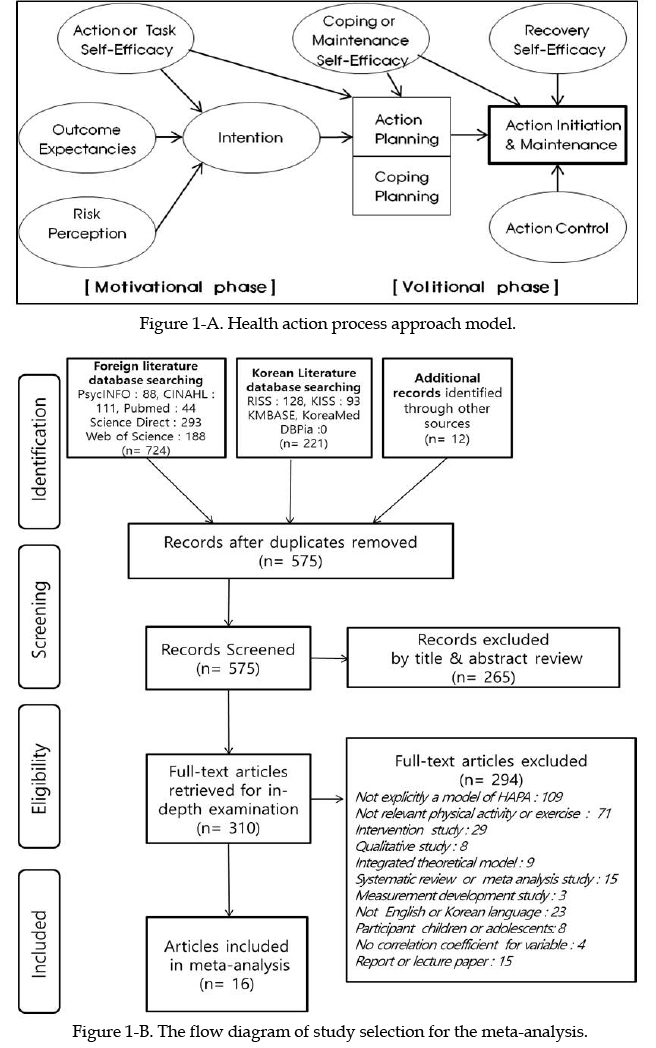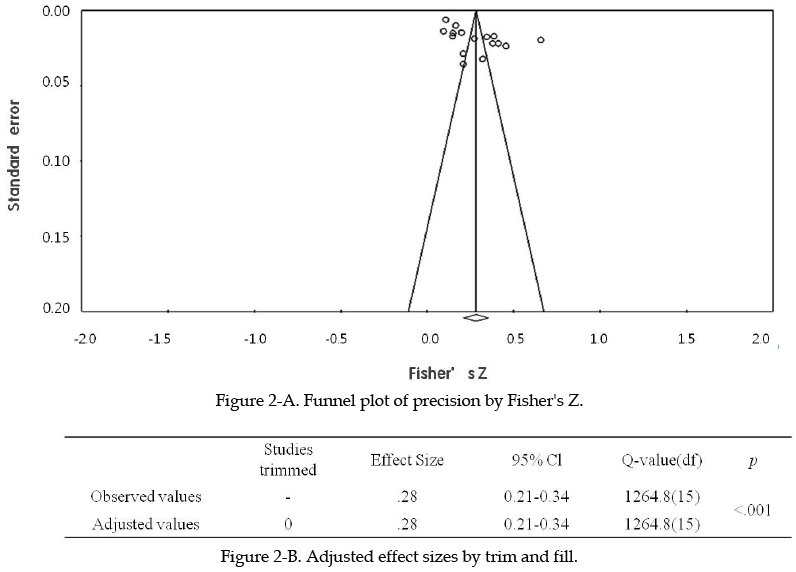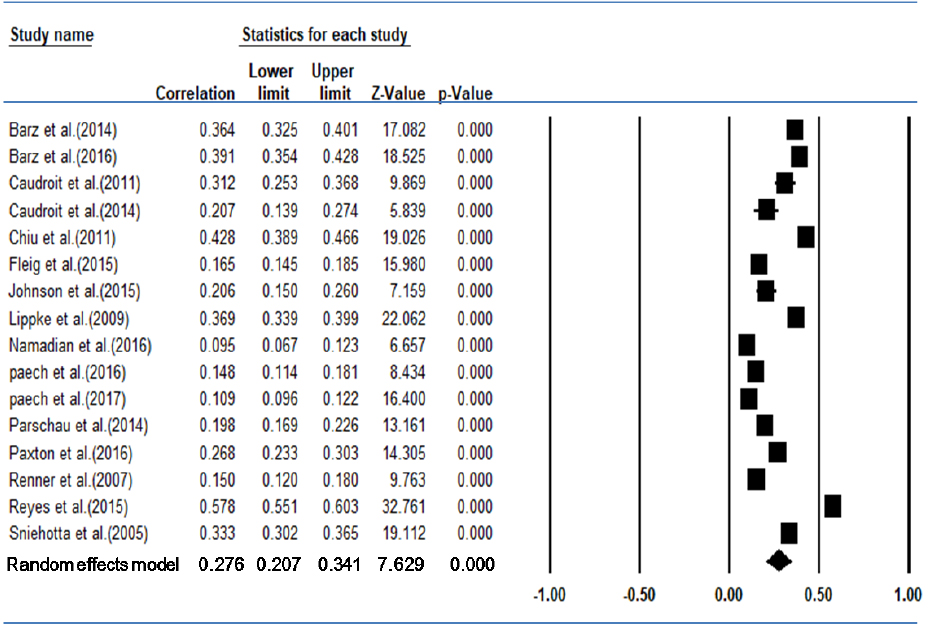J Korean Acad Community Health Nurs.
2018 Sep;29(3):359-370. 10.12799/jkachn.2018.29.3.359.
Effects of the Variables related to the Health Action Process Approach Model on Physical Activity: A Systematic Literature Review and Meta-analysis
- Affiliations
-
- 1Doctoral Student, The Graduate School, Ewha Womans University, Seoul, Korea.
- 2Researcher, Division of TB Epidemic Investigation, Korea Center for Disease Prevention, Cheongju, Korea.
- 3Professor, College of Nursing, Ewha Womans University, Seoul, Korea. yangsj@ewha.ac.kr
- KMID: 2429990
- DOI: http://doi.org/10.12799/jkachn.2018.29.3.359
Abstract
- PURPOSE
The purpose of this study is to identify effects of the variables of Health Action Process Approach (HAPA) Model on physical activity.
METHODS
This study has conducted a systematic literature review and meta-analysis. Sixteen articles were searched through electronic databases (PsycINFO, PubMed, CINAHL, Web of science, Science Direct, RISS, KMBASE, KoreaMed, KISS, DBpia) and additional journals from 2000 to July, 2017. To estimate the effect size (ES), the meta-analysis of the studies was performed by using Comprehensive Meta-Analysis programs.
RESULTS
The overall effect size of the variables of HAPA on physical activity was median (ES=.28). Of the core variables of HAPA model, action control (ES=.43) showed the largest effect size, followed by coping self-efficacy (ES=.31) and planning (ES=.31).Additional variables were identified as preparatory behavior (ES=.39) and past physical activity (ES=.24). Through the moderator effect analysis, the effect size was higher in the volitional phase than in the motivational phase, and higher in the healthy group than in the patient group. The higher the proportion of males and the lower the age, the larger the effect size.
CONCLUSION
This finding shows empirical evidence that all core variables of the HAPA model are useful for predicting physical activity. We propose the use of the HAPA model to develop physical activity promotion intervention.
Keyword
MeSH Terms
Figure
Reference
-
1. Lee IM, Shiroma EJ, Lobelo F, Puska P, Blair SN, Katzmarzyk PT. Effect of physical inactivity on major non-communicable diseases worldwide: An analysis of burden of disease and life expectancy. Lancet. 2012; 380(9838):219–229. DOI: 10.1016/S0140-6736(12)61031-9.
Article2. World Health Organization. Global health risks: mortality and burden of disease attributable to selected major risks. Geneva, Switzerland: WHO;2009. 62 p.3. World Health Organization. Global recommendations on physical activity for health. Geneva, Switzerland: WHO;2010. 59 p.4. Kown YM, Cho OS. An investigation on operational definition of regular physical activity: A systematic review. Korean J Sports Sci. 2015; 24(6):1339–1350.5. Milton K, Gale J, Stamatakis E, Bauman A. Trends in prolonged sitting time among European adults: 27 country analysis. Prev Med. 2015; 77:11–16. DOI: 10.1016/j.ypmed.2015.04.016.
Article6. Schwarzer R. Modeling health behavior change: How to predict and modify the adoption and maintenance of health behaviors. Appl Psychol. 2008; 57(1):1–29. DOI: 10.1111/j.1464-0597.2007.00325.x.
Article7. Bae SS. Theory and approach method of health promotion. Seoul, Korea: Gyechuk Munwhasa;2012. 524 p.8. Scholz U, Roger K, Sonja P. Predicting behavioral intentions and physical exercise: A test of the health action process approach at the intrapersonal level. Health Psychol. 2009; 28(6):702–708. DOI: 10.1037/a0016088.
Article9. Schwarzer R. Health Action Process Approach (HAPA) as a theoretical framework to understand behavior change. Actualidades en Psicologíia. 2016; 30(121):119–130. DOI: 10.15517/ap.v30i121.23458.
Article10. Sniehotta FF, Scholz U, Schwarzer R. Bridging the intentionbehaviour gap: Planning, self-efficacy, and action control in the adoption and maintenance of physical exercise. Psychol Health. 2005; 20(2):143–160. DOI: 10.1080/08870440512331317670.
Article11. Gholami MN, Knoll N, Schwarzer R. Application of the Health Action Process Approach to Physical Activity: a meta Analysis [Internet]. Self Regulation and Health Behavior Across the Life Span;2013. cited 2014 June 27. Available from: https://d-nb.info/1053653794/34#page=47.12. Fernández BR, Fleig L, Godinho CA, Montenegro EM, Knoll N, Schwarzer R. Action control bridges the planning behaviour gap: A longitudinal study on physical exercise in young adults. Psychol Health. 2015; 30(8):911–923. DOI: 10.1080/08870446.2015.1006222.13. Kang H. Statistical considerations in meta-analysis. Hanyang Med Rev. 2015; 35(1):23–32. DOI: 10.7599/hmr.2015.35.1.23.
Article14. Borenstein M, Hedges LV, Higgins JPT, Rothstein HR. Introduction to meta analysis. West Sussex, UK: Wiley;2009. 421 p.15. Caspersen CJ, Powell KE, Christenson GM. Physical activity, exercise, and physical fitness: Definitions and distinctions for health-related research. Public Health Rep. 1985; 100(2):126–131.16. Downs SH, Black N. The feasibility of creating a checklist for the assessment of the methodological quality both of randomised and non-randomised studies of health care interventions. J Epidemiol Community Health. 1998; 52(6):377–384. DOI: 10.1136/jech.52.6.377.
Article17. Kirk MA, Rhodes RE. Occupation correlates of adults' participation in leisure-time physical activity: A systematic review. Am J Prev Med. 2011; 40(4):476–485. DOI: 10.1016/j.amepre.2010.12.015.18. Anderson JC, Gerbing DW. Structural equation modeling in practice: A review and recommended two-step approach. Psychological bulletin. 1988; 103(3):411–423. DOI: 10.1037/0033-2909.103.3.411.
Article19. Gordis L. Epidemiology. 4th ed. Philadelphia, US: Saunders Elsevier;2009. 375 p.20. Duval S, Tweedie R. Trim and fill: A simple funnel-plot-based method of testing and adjusting for publication bias in meta analysis. Biometrics. 2000; 56(2):455–463. DOI: 10.1111/j.0006-341X.2000.00455.x.21. Higgins JPT, Thompson SG, Deeks JJ, Altman DG. Measuring inconsistency in meta-analyses. British Medical Journal. 2003; 327(7414):557–560. DOI: 10.1136/bmj.327.7414.557.
Article22. Cohen J. Statistical power analysis for the behavioral sciences. 2nd ed. Mahwah. NJ: Lawrence Earlbaum Associates;1988. 567 p.23. Gourlan M, Bernard P, Bortolon C, Romain AJ, Lareyre O, Carayol M, et al. Efficacy of theory-based interventions to promote physical activity. A meta-analysis of randomised controlled trials. Health Psychol Rev. 2016; 10(1):50–66. DOI: 10.1080/17437199.2014.981777.
Article24. Renner B, Spivak Y, Kwon S, Schwarzer R. Does age make a difference? Predicting physical activity of South Koreans. Psychol Aging. 2007; 22(3):482–493. DOI: 10.1037/0882-7974.22.3.482.
Article25. Johnson ET, Lynch RT, Chan F, Bezyak J, Mahr M. Expanding the health action and process approach to predict physical activity in African Americans with HIV/AIDS: A hierarchical regression analysis. Rehabil Couns Bull. 2015; 59(1):30–42. DOI: 10.1177/0034355215573794.26. Barz M, Parschau L, Warner LM, Lange D, Fleig L, Knoll N, et al. Planning and preparatory actions facilitate physical activity maintenance. Psychol Sport Exerc. 2014; 15(5):516–520. DOI: 10.1016/j.psychsport.2014.05.002.
Article27. Chiu CY, Lynch RT, Chan F, Berven NL. The Health Action Process Approach as a motivational model for physical activity self management for people with multiple sclerosis: A path analysis. Rehabilitation Psychology. 2011; 56(3):171–181. DOI: 10.1037/a0024583.28. Scarapicchia TMF, Amireault S, Faulkner G, Sabiston CM, Sabiston CM. Social support and physical activity participation among healthy adults: A systematic review of prospective studies. Int Rev Sport Exerc Psychol. 2017; 10(1):50–83. DOI: 10.1080/1750984X.2016.1183222.
Article29. World Health Organization. Global status report on noncommunicable disease 2014. Geneva, Switzerland: WHO;2015. 279 p.30. Korea Centers for Disease Control & Prevention. 2016 Health behavior and chronic disease statistics. Cheongju, South Korea: KCDC;2017. 58 p.
- Full Text Links
- Actions
-
Cited
- CITED
-
- Close
- Share
- Similar articles
-
- Factors Associated With Health-promoting Behaviors Among Nurses in South Korea: Systematic Review and Meta-analysis Based on Pender's Health Promotion Model
- Systematic Review and Meta-analysis in Digestive Cancer Research
- Correlates of Cognitive Impairment of Rheumatic Disease: Systematic Review and Meta-analysis
- Meta-epidemiology
- Exercise and adults with hemophilia: a systematic review and meta-analysis




